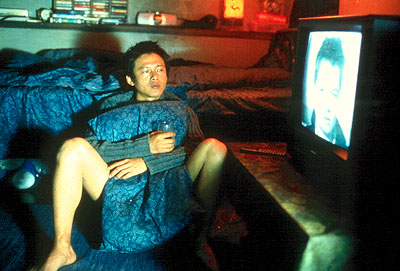
|
What Time is it There?Review by Chris HydeMarch 2, 2002
Taiwanese filmmaker Tsai Ming-Liang burst onto the international art-house circuit with his 1992 Rebels of a Neon God, and has since steadily produced a body of work that places him amongst the greatest working filmmakers today. Like some of his contemporaries on the Asian art-film circuit (notably Tran Anh Hung and Wong Kar Wai), his work displays an Asian sensibility that has been filtered through the influence of the French New Wave. This influence is palpably evident in his brilliant new work What Time is it There?, where at one point the narrative stops and the frame is given over completely to show a long snippet of Francois Truffaut's The 400 Blows, reportedly the director's favorite film. To see Tsai Ming-Liang as merely another slavish devotee to the body of work produced by the children of Cahiers du Cinema is to miss the point, however. For while his work undoubtedly evokes the spirit of the greatest period in French cinema, the aesthetic here is uniquely Asian, and the style decidedly his own. The plot of What Time is it There? is relatively minimal, simply concerning a father who dies suddenly and leaves a lonely widow and son. Soon after his death, the son, who sells watches on the streets of Taiwan, has a young woman visit his stand and cajole him into selling her his own personal watch. On the eve of her leaving to go to Paris, they conduct the transaction, and the woman gives him a cake as a gift. To hold on to this tenuous connection with her, he begins to obsessively change every clock he can find to Paris time, and the rest of the film delves into the lives of this man, his mother, and the woman who he met so briefly. The action unfolds inside a geography of dislocation, where alienation and loneliness spin from generation to generation, from city to city and from gender to gender. While this all might sound unremittingly bleak, Tsai interjects moments of offbeat humor that manage somewhat to temper the generally neo-realist style of the rest of the film. In addition, the performances of Kang-sheng Lee (as the son), Yi-ching Lu (the mother), and Shiang-chyi Chen (as the young woman in Paris) are so assured that it's hard to imagine that these characters won't ultimately manage to survive their existential predicament. Yet there is undoubtedly an undercurrent of sadness and melancholy that flows throughout the body of the movie, as these people struggle to find their place in the world, looking to carve out somewhere to be happy, some way to exist on this plane without succumbing to the stultifying anomie the universe can sometimes bring to bear on the individual. However, with the director's exquisite sensibility, the drama unfolds with balance and grace, and the more bitter aspects of the human condition get to play counterpoint with moments of beauty and comedy. Full of mid- and long shots and played out in well-paced, mostly wordless scenes of varying tempo, What Time is it There? succeeds mainly through the deft touch of its director, the capable performances of the cast and the universality of its milieu. While oft times bleak and unsettling, the film also revels in its ambiguity and absurd asides, allowing the viewer to comprehend the poignancy of a hundred small moments without being oppressed by their meaning. The entire exercise is also book-ended by a wonderful directorial device that, while cryptic, may indicate that the world of these people (and ours?) perhaps contains the possibility of hope. But with a filmmaker as brilliant and skilled as this one, it's rarely a good idea to imagine that you know exactly what it is he meant to say with a film; instead, it's often preferable to just watch it unfold before your eyes and let yourself be enveloped in the shimmering, meaningful cascade that good cinema can be. |
Friday, November 01, 2024
© 2006 Box Office Prophets, a division of One Of Us, Inc.